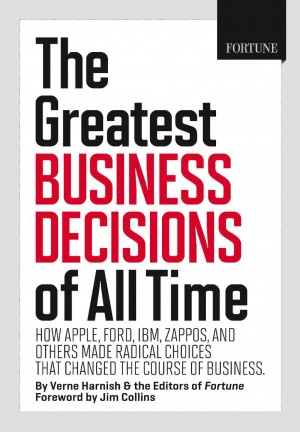You too can make great judgment calls

“The Greatest Business Decisions of All Time” by Verne Harnish & Fortune Editors, Fortune Books, 2012
A leading automobile manufacturer doubled the wages of its workforce to increase productivity and enable its workers to buy the cars they produced.
A manufacturer of fighter jets decided to expand into making passenger airlines, later considered the greatest development in commercial aviation.
The board of a legendary computer maker struggled over recalling its founder, Steve Jobs, to bring back the magic—and big market share. Jobs was fired 20 years before.
The above are just some of the great decisions made by a company’s owners or board, which have had great impact on their market leadership and on their corporate future.
These are detailed in a book titled “The Greatest Business Decisions of All Time,” jointly authored by Verne Harnish and the editors of Fortune.
Article continues after this advertisementThe book cites Henry Ford’s decision in 1914 as the “single greatest decision of all time.”
Article continues after this advertisementThe legendary carmaker doubled his workers’ wages from 2.50 to 5 dollars. He justified his decision on this dramatic thought: “My workers should be able to afford the very products they were producing.”
The book author says that the moving assembly line and Ford’s Model T were two of his greatest achievements. Paying high wages ushered in the advent of enlightened capitalism—which also raised productivity and motivation among the work force.
In 1952 Boeing CEO Bill Allen persuaded his board to invest $16 million in the Boeing 707. Earlier, Boeing was a manufacturer of fighter planes.
The shift from making fighter jets to manufacturing passenger planes was a paradigm shift for CEO Allen. At the time, in the mid-1950s, Douglas Aircraft dominated the passenger airline industry with its DC-3s.
Even against a formidable competitor plus the uncertainty of making a success out of a strategic shift to “business-to-consumer” from “business-to-business” marketing, Boeing made its commercial flight on Oct 26, 1958. On that historic flight, Boeing ushered in a new era in civil aviation.
Intel was facing problems due to the dramatic growth of the microprocessor industry, where it was a leading player.
Intel executives, led by Andy Grove, made attempts at product differentiation for a highly commoditized product. First, they tried to use numbers—like 286 and 386 to make a distinction. Numerics didn’t click. Then, the firm decided to introduce a phrase: “Intel, the Computer Inside.” This was ruled out, because it tended to signal that Intel is competing with its clients—who are computer makers.
So, “Intel Inside” became the catchphrase. It’s a classic in branding. Intel retook the market by storm. Today, it maintains its 80 percent share of the microprocessor market.
In 1985, Steve Jobs was asked to go by the board. Since then, there was a succession of CEO hirings and firings. Apple continued to incur losses from bad strategies, wrong acquisition decisions, and simply hiring the “ultimate wrong guys,” according to the author.
The Apple Board tried to get Steve back by buying NeXT, Job’s firm at that time. To cut the story short, in 1997, Steve Jobs was not attracted back to Apple as CEO.
When Jobs reclaimed his CEO position, he brought the magic back to Apple. In the few years Jobs was at the helm, he dramatically launched products that were all smashing successes.
Decisions for greatness
The book, an easy read, is a good treat to executives and aspiring ones who need tips on making winning decisions. They don’t have to be great. They just have to be good decisions that will assure a bigger market share and a viable business future.
And yet Jim Collins, who wrote the foreword for this book reminds us: “Great decisions were made by leaders for the long-term greatness of the company.”
He reminds business leaders here and around the world that great decisions do not come as flash-in-the-pan phenomena or emanating from a “fix-it” mentality.
Executives, you too can make good-to-great decisions, using as model every executive judgment call in this book. [email protected]